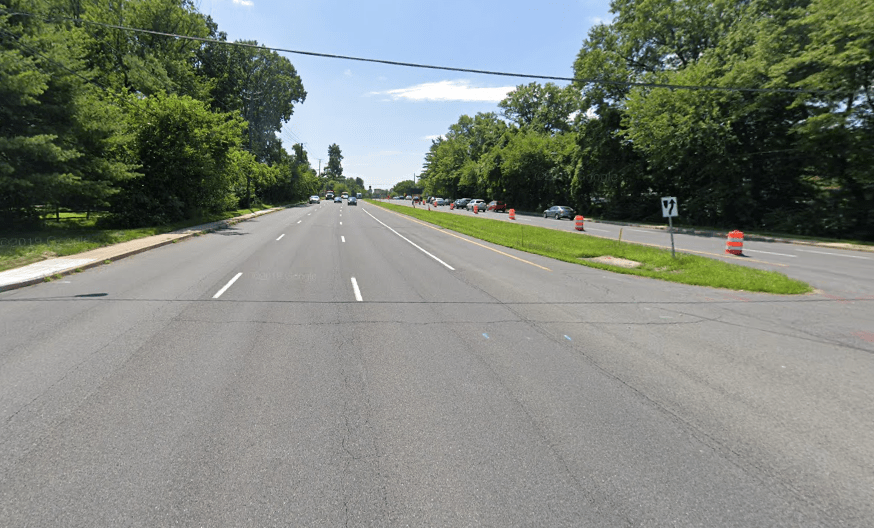A Maryland woman was killed by a driver just 1,000 feet from where her husband was killed crossing the same dangerous road, raising questions about why even Vision Zero cities so often fail to adequately redesign streets that repeatedly prove fatal to walkers.
Claire Weissmeyer Grossmann, 63, had just gotten off a bus from work on a six-lane stretch of Georgia Avenue in Silver Spring, Md. when she was struck by 19-year-old German Alexis Del Cid Mejia, who was driving a 2015 Toyota Camry on April 28.
Following more than a dozen pedestrian crashes at that intersection in 2019 alone (and at least three other walker fatalities since 2009), the state highway administration lowered speed limits, adjusted signal timing, and made other safety improvements to the road in January of last year. But engineers had opted not to shorten the crossing distance, install HAWK signals, or perform other design changes that might have saved Grossmann’s life.
It's not like they hadn't been warned. In a disturbing echo, Weissmeyer Grossmann’s husband, Robert Grossmann, 64, was killed by a driver at an intersection just two blocks away on the same street in 2016. At the time of his crash, neither stretch of the road was outfitted with even a simple marked crosswalk; it took nearly four years to install one near the site where Weissmeyer Grossmann died five years later, but it was not enough to save his wife's life.
Family told local media that the couple did not own a car and relied on public transit to meet their transportation needs.
I wrote to @MoCoCouncilMD & was disappointed by the response I got. They are fine moving with the current glacial pace of @VisionZeroMC & there doesn't seem to be political will to really push @MDSHA to make changes to save lives. Letters aren't enough.
— Brigid Howe (@bnhowe) May 11, 2021
Perhaps more disturbing, though, is the larger trend of traffic violence in the county where the Grossmanns were killed — and the region’s slow response to it.
Despite being one of the first counties in the United States to adopt a Vision Zero target — and a promised $267-million investment in pedestrian and cyclists across six years — Montgomery County has consistently fallen short of its goal to reduce serious pedestrian and cyclist crashes. In 2019, the county exceeded its target for serious walking injuries by nearly 60 percent; in 2020, another 15 people died on its roadways, often on state-owned arterials that are maintained outside the regional transportation authority.
Maryland, it should be noted, became one of the few Vision Zero states in 2019 — but that doesn’t mean state transportation leaders have always responded adequately in the wake of pedestrian deaths. Following a spate of fatalities in January 2020, the state highway administration announced initial crash analyses that found that neither road conditions nor driver behavior played a role in any of the incidents, though local media said the agency only made note of the absence of the most egregious potential roadway design failures, like broken pedestrian signals or malfunctioning streetlamps, rather than the highway-style design of the road itself. (Officials did, however, pat themselves on the back at this press conference for the minor safety improvements at the intersection where Weissmeyer Grossmann would later lose her life.)
“We know that that particular area of Aspen Hill has been really problematic,” Montgomery County council member Nancy Navarro, who is pushing for a full safety review of the road, told NBC Washington.
Other outlets have nonetheless inaccurately referred to crashes like Weissmeyer Grossmann’s as “accidents,” and called the location of her husband’s death on the same road a “tragic coincidence.”
This story is Bullsh*t. “There are also no clear indicators that any of the fatalities were related to roadway conditions”
— Bill Schultheiss (@schlthss) May 11, 2021
-6 to 7 lanes= multiple threat = need signal
-darkness= need street light
-off-peak= higher speed = need speed camera or fewer lanes https://t.co/fTixcqReiw
The deaths of the Grossmanns, of course, are not accidents, and they were certainly not a coincidence. They are the direct result of a transportation system that consistently fails to prioritize the safety of people who walk over the convenience of people who drive — even when pedestrians are struck on the same dangerous segments of the same dangerous roads, year after year, with only a handful of safety upgrades in response.
Like the more than 40 communities across the country that have committed to ending traffic violence, Montgomery County and the state of Maryland should be applauded for at least acknowledging that roadway deaths are preventable. But until all our cities, states and the federal guidelines that they look to reckon with dangerous road designs before pedestrians are struck — or, at the absolute bare minimum, immediately after a single walker is killed — American communities will never meet that eminently achievable goal.





